Bibliometric and visualized analysis of 3D printing bioink in bone tissue engineering
- PMID: 37545887
- PMCID: PMC10400721
- DOI: 10.3389/fbioe.2023.1232427
Bibliometric and visualized analysis of 3D printing bioink in bone tissue engineering
Abstract
Background: Applying 3D printed bioink to bone tissue engineering is an emerging technology for restoring bone tissue defects. This study aims to evaluate the application of 3D printing bioink in bone tissue engineering from 2010 to 2022 through bibliometric analysis, and to predict the hotspots and developing trends in this field. Methods: We retrieved publications from Web of Science from 2010 to 2022 on 8 January 2023. We examined the retrieved data using the bibliometrix package in R software, and VOSviewer and CiteSpace were used for visualizing the trends and hotspots of research on 3D printing bioink in bone tissue engineering. Results: We identified 682 articles and review articles in this field from 2010 to 2022. The journal Biomaterials ranked first in the number of articles published in this field. In 2016, an article published by Hölzl, K in the Biofabrication journal ranked first in number of citations. China ranked first in number of articles published and in single country publications (SCP), while America surpassed China to rank first in multiple country publications (MCP). In addition, a collaboration network analysis showed tight collaborations among China, America, South Korea, Netherlands, and other countries, with the top 10 major research affiliations mostly from these countries. The top 10 high-frequency words in this field are consistent with the field's research hotspots. The evolution trend of the discipline indicates that most citations come from Physics/Materials/Chemistry journals. Factorial analysis plays an intuitive role in determining research hotspots in this sphere. Keyword burst detection shows that chitosan and endothelial cells are emerging research hotspots in this field. Conclusion: This bibliometric study maps out a fundamental knowledge structure including countries, affiliations, authors, journals and keywords in this field of research from 2010 to 2022. This study fills a gap in the field of bibliometrics and provides a comprehensive perspective with broad prospects for this burgeoning research area.
Keywords: 3D printing; bibliometrics; bioink; biomaterial; bone tissue engineering; data visualization; hydrogel.
Copyright © 2023 Xu, Yu, Wang, Zhang and Zhang.
Conflict of interest statement
The authors declare that the research was conducted in the absence of any commercial or financial relationships that could be construed as a potential conflict of interest.
Figures

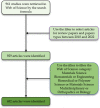
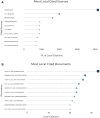

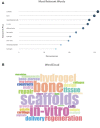
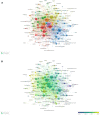


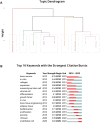
Similar articles
-
Knowledge domain and hotspots concerning photosensitive hydrogels for tissue engineering applications: A bibliometric and visualized analysis (1996-2022).Front Bioeng Biotechnol. 2022 Nov 14;10:1067111. doi: 10.3389/fbioe.2022.1067111. eCollection 2022. Front Bioeng Biotechnol. 2022. PMID: 36466359 Free PMC article.
-
Knowledge domain and hotspots analysis concerning applications of two-photon polymerization in biomedical field: A bibliometric and visualized study.Front Bioeng Biotechnol. 2022 Sep 30;10:1030377. doi: 10.3389/fbioe.2022.1030377. eCollection 2022. Front Bioeng Biotechnol. 2022. PMID: 36246385 Free PMC article.
-
A Bibliometric Analysis of Research on Decellularized Matrix for Two Decades.Tissue Eng Part C Methods. 2023 Sep;29(9):395-409. doi: 10.1089/ten.TEC.2023.0013. Epub 2023 Jul 7. Tissue Eng Part C Methods. 2023. PMID: 37276179 Review.
-
Research trends of bone tumor treatment with 3D printing technology from 2013 to 2022: a bibliometric analysis.Discov Oncol. 2024 Aug 19;15(1):359. doi: 10.1007/s12672-024-01207-6. Discov Oncol. 2024. PMID: 39160379 Free PMC article.
-
Bioprinted hydrogels in bone regeneration: a bibliometric analysis.Front Pharmacol. 2025 Feb 3;16:1532629. doi: 10.3389/fphar.2025.1532629. eCollection 2025. Front Pharmacol. 2025. PMID: 39963238 Free PMC article. Review.
Cited by
-
Bibliometric and visualized analysis of hydrogels in organoids research.Regen Ther. 2024 Feb 23;25:395-404. doi: 10.1016/j.reth.2024.02.004. eCollection 2024 Mar. Regen Ther. 2024. PMID: 38435088 Free PMC article. Review.
-
Adipose-Derived Stem Cells for Cartilage Tissue Engineering: A Bibliometric Analysis of Trends and Themes.J Multidiscip Healthc. 2025 May 30;18:3023-3037. doi: 10.2147/JMDH.S522203. eCollection 2025. J Multidiscip Healthc. 2025. PMID: 40463583 Free PMC article.
-
3D bioprinted biomimetic MOF-functionalized hydrogel scaffolds for bone regeneration: Synergistic osteogenesis and osteoimmunomodulation.Mater Today Bio. 2025 Apr 8;32:101740. doi: 10.1016/j.mtbio.2025.101740. eCollection 2025 Jun. Mater Today Bio. 2025. PMID: 40270888 Free PMC article.
References
-
- Aslam Khan M. U., Al-Arjan W. S., Binkadem M. S., Mehboob H., Haider A., Raza M. A., et al. (2021). Development of biopolymeric hybrid scaffold-based on AAc/GO/nHAp/TiO(2) nanocomposite for bone tissue engineering: In-vitro analysis. Nanomater. (Basel) 11, 1319. 10.3390/nano11051319 - DOI - PMC - PubMed
Publication types
LinkOut - more resources
Full Text Sources
Miscellaneous

